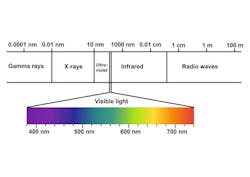Electromagnetic spectrum covers many wavelength regions from Gamma ray, X ray, ultraviolet (UV), visible light, infrared (IR) to radio wave. Visible light is the portion of the electromagnetic spectrum that the human eye is capable of detecting. Visible light has a wavelength range from 380 to 780nm and different wavelengths appear to human eye as different colors.
An optical filter selectively transmits light of different wavelengths while absorbing or blocking the remainder. These filters usually pass long wavelengths only (longpass filter), or short wavelengths only (shortpass filter), or a certain wavelength range (bandpass filter), or multiple wavelength regions (multi-bandpass filter).
Types of Filters
Longpass filters suppress shorter wavelengths and transmit longer wavelengths while shortpass filters suppress longer wavelengths and transmit shorter wavelengths.
Bandpass filters have high transmission for a certain wavelength range while blocking other wavelengths, i.e. filter out unwanted light spectrums. These types of filters are referred to by the transmission wavelength range, also known as the passband, which they are designed to transmit.
A Multi-bandpass filter can have high transmission at multiple wavelength regions while blocking other wavelengths of the light.
Notch filters block a certain wavelength range while allowing the light on either side of that range to pass through. These filters are the inverse of a bandpass filter.
Neutral density filters reduce or modify the intensity levels of all wavelengths (or colors of light) equally, resulting in no change in hue or color rendition, similar to a pair of sunglasses blocking the light coming into the glass in a neutral way without changing the color of the light.
Typical Applications
Optical filters are used in photography, optical instruments, color lighting, astronomy, and are essential in fluorescence microscopy and spectroscopy.
Fluorescence filters, used in fluorescence microscopy systems, are typically longpass or dichroic, shortpass, and bandpass filters.
Laser line filters (extremely narrow bandpass filters), are used in laser scanners and other laser devices. They prevent distortion of measurement signals and increase image contrast and are also used to screen out all unwanted laser background radiation and ambient light.
Raman filters (notch filters) are used in Raman spectroscopy. These filters transmit Raman scattered light to the detector while blocking the laser line.
Machine vision filters (bandpass filters) are used to block unwanted light spectrum and improve the image contrast for machine vision camera and sensor applications.
